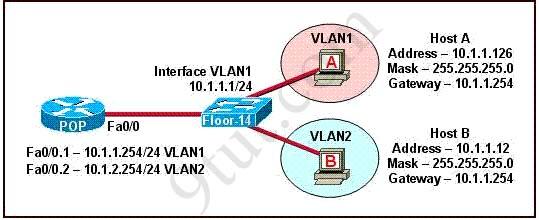
- •Explanation
- •1. Flash (the default location) 2. Tftp server 3. Rom (used if no other source is found)
- •Question 3
- •In a switched environment, what does the ieee 802.1q standard describe?
- •Question 8
- •Question 3
- •Vlan 3 is not yet configured on your switch. What happens if you set the switchport access vlan 3 command interface configuration mode?
- •Explanation
- •In the Frame Relay network, which ip addresses whould be assigned to the interfaces with point-to-point pvCs?
- •It has become necessary to configure an existing serial interface to accept a second Frame Relay virtual circuit. Which of the following are required to solve this? (Choose three)
- •If ip routing is enabled, which two commands set the gateway of last resort to the default gateway? (Choose two)
- •Question 8
- •Explanation
- •Explanation
- •If the startup-config file is missing or does not specify a location, it will check the following locations for the ios image:
- •Question 4
- •Explanation
- •Explanation
Explanation
The principle here is if the subnet mask makes two IP addresses 10.1.0.36 and 10.1.1.70 in the same subnet then the Network device A does not need to have IP addresses on its interfaces (and we don’t need a Layer 3 device here).
A quick way to find out the correct answers is notice that all 255.255.255.x subnet masks will separate these two IP addresses into two separate subnets so we need a Layer 3 device here and each interface must require an IP address on a unique IP subnet -> A, C are not correct while B, D are correct.
With 255.255.254.0 subnet mask, the increment here is 2 in the third octet -> the first subnet is from 10.1.0.0 to 10.1.1.255, in which two above IP addresses belong to -> each interface of Network device A does not require an IP address -> E is correct.
Question 3
What are three reasons that an organization with multiple branch offices and roaming users might implement a Cisco VPN solution instead of point-to-point WAN links? (Choose three)
A. reduced cost B. better throughput C. broadband incompatibility D. increased security E. scalability F. reduced latency
Answer: A D E
Question 4
What two things will a router do when running a distance vector routing protocol? (Choose two)
A. Send periodic updates regardless of topology changes. B. Send entire routing table to all routers in the routing domain. C. Use the shortest-path algorithm to the determine best path. D. Update the routing table based on updates from their neighbors. E. Maintain the topology of the entire network in its database.
Answer: A D
Question 5
What is the purpose of the inverse ARP?
A. to map a known DLCI to an IP address B. to map a known IP address to a MAC address C. to map known SPID to a MACaddress D. to map a known DLCI to a MAC address E. to map a known IP address to a SPID. F. to map a known MAC address to an IP address
Answer: A
Explanation
For more information about Inverse ARP, please read my Frame Relay tutorial.
Question 6
The network shown in the diagram is experiencing connectivity problems. Which of the following will correct the problems? (Choose two.)

A. Configure the gateway on Host A as 10.1.1.1. B. Configure the gateway on Host B as 10.1.2.254. C. Configure the IP address of Host A as 10.1.2.2. D. Configure the IP address of Host B as 10.1.2.2. E. Configure the masks on both hosts to be 255.255.255.224. F. Configure the masks on both hosts to be 255.255.255.240.
Answer: B D
Question 7
Refer to the exhibit. For what two reasons has the router loaded its IOS image from the location that is shown? (Choose two)
|
Router1> show version Cisco Internetwork Operating System Software IOS ™ 7200 Software (C7200-J-M), Experimental Version 11.3tl997091S:1647S2) [hampton-nitro-baseline 249] Copyright (c) 1986-1997 by cisco Systems, Inc. Compiled Wed 08-0ct-97 06:39 by hampton Image text-base: 0×60008900, data-base: 0x60B98000 ROM: System Bootstrap, Version 11.1(11855) [beta 2], INTERIM SOFTWARE BOOTPLASH: 7200 Software (C7200-BOOT-M), Version 11.1(472), RELEASE SOFTWARE (fcl) Router1 uptime is 23 hours, 33 minutes System restarted by abort at PC 0x6022322C at 10:50:SS PDT Tue Oct 21 1997 System image file is “tftp://112.16.1.129/hampton/nitro/c7200-j-mz” cisco 7206 (NPE150) processor with 57344K/8192K bytes of memory. Configuration register is 0×2102 |
A. Router1 has specific boot system command that instruct it to load IOS from TFTP server. B. Router1 is acting as a TFTP server for other routers. C. Router1 cannot locate a valid IOS image in flash memory. D. Router1 defaulted to ROMMON mode and loaded the IOS image from a TFTP sewer. E. Cisco routers will first attempt to load a image from TFTP for management purposes.
Answer: A C
